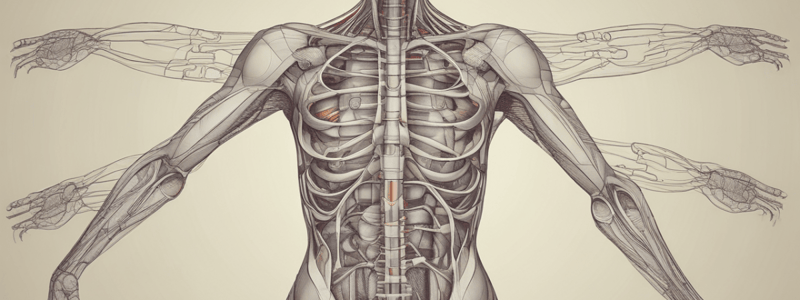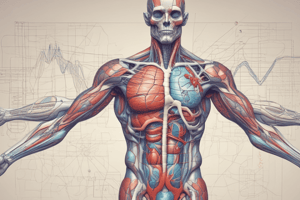Podcast
Questions and Answers
What is the fluid that surrounds our cells called?
What is the fluid that surrounds our cells called?
- Extracellular fluid (correct)
- Intracellular fluid
- Plasma
- Interstitial fluid
What is the substance present in the greatest amount in a solution?
What is the substance present in the greatest amount in a solution?
- Molecule
- Solvent (correct)
- Solute
- Mixture
What is the concentration of a solution?
What is the concentration of a solution?
- The type of solute in a solution
- The amount of solvent in a solution
- The amount of solute in a solution
- The ratio of solute to solvent in a solution (correct)
What is the fluid inside our cells called?
What is the fluid inside our cells called?
What is an example of a solute in a saltwater solution?
What is an example of a solute in a saltwater solution?
What is the term for a homogeneous mixture of two or more substances?
What is the term for a homogeneous mixture of two or more substances?
What is the fluid that makes up the extracellular fluid of our blood?
What is the fluid that makes up the extracellular fluid of our blood?
What is the term for the substances present in smaller amounts in a solution?
What is the term for the substances present in smaller amounts in a solution?
What is an example of a liquid solution in physiology?
What is an example of a liquid solution in physiology?
What is the fluid that surrounds our tissues called?
What is the fluid that surrounds our tissues called?
What is the normal range of fasting blood glucose levels?
What is the normal range of fasting blood glucose levels?
What is the concentration of sodium chloride in normal saline solutions found in IV fluids?
What is the concentration of sodium chloride in normal saline solutions found in IV fluids?
What is the primary function of the cell membrane in terms of osmosis?
What is the primary function of the cell membrane in terms of osmosis?
Which of the following molecules can dissolve into the lipid portion of the phospholipid bilayer and cross the cell membrane by simple diffusion?
Which of the following molecules can dissolve into the lipid portion of the phospholipid bilayer and cross the cell membrane by simple diffusion?
What is the term for solutes that are unable to easily cross the cell membrane?
What is the term for solutes that are unable to easily cross the cell membrane?
What is the term for the movement of water across the cell membrane towards the solution with a higher concentration of osmotically active solute particles?
What is the term for the movement of water across the cell membrane towards the solution with a higher concentration of osmotically active solute particles?
What is the term for the effect of an extracellular solution on cell volume and shape?
What is the term for the effect of an extracellular solution on cell volume and shape?
What is the term for a solution that draws water out of the cell, resulting in crenation?
What is the term for a solution that draws water out of the cell, resulting in crenation?
What is the appearance of a solution that contains cells when viewed with the naked eye?
What is the appearance of a solution that contains cells when viewed with the naked eye?
What is the appearance of a crenated red blood cell under the microscope?
What is the appearance of a crenated red blood cell under the microscope?
In a saltwater solution, water is the solute.
In a saltwater solution, water is the solute.
The extracellular fluid of our blood is known as interstitial fluid.
The extracellular fluid of our blood is known as interstitial fluid.
Concentration of a solution is defined as solvent/solute.
Concentration of a solution is defined as solvent/solute.
Solutions can be solid, liquid, or gas.
Solutions can be solid, liquid, or gas.
The intracellular fluid is an example of an extracellular fluid.
The intracellular fluid is an example of an extracellular fluid.
A solution is a heterogeneous mixture of two or more substances.
A solution is a heterogeneous mixture of two or more substances.
The concentration of a solution is always measured in percentage.
The concentration of a solution is always measured in percentage.
In a solution, the solvent is always a solid.
In a solution, the solvent is always a solid.
The extracellular fluid of our tissues is known as plasma.
The extracellular fluid of our tissues is known as plasma.
A solution can have only two substances.
A solution can have only two substances.
A cell membrane is impermeable to water due to the presence of aquaporins.
A cell membrane is impermeable to water due to the presence of aquaporins.
A solution with a concentration of 0.9% NaCl is considered hypertonic.
A solution with a concentration of 0.9% NaCl is considered hypertonic.
Large, charged molecules can cross the cell membrane by simple diffusion.
Large, charged molecules can cross the cell membrane by simple diffusion.
A cell will lose water and become crenated in a hypotonic solution.
A cell will lose water and become crenated in a hypotonic solution.
Tonicity refers to the concentration of solutes inside a cell.
Tonicity refers to the concentration of solutes inside a cell.
A solution with a pH of 7.4 is considered acidic.
A solution with a pH of 7.4 is considered acidic.
The concentration of osmotically active solutes is critical for cell shape and function.
The concentration of osmotically active solutes is critical for cell shape and function.
The kidney is responsible for maintaining the concentration of osmotic balance in the body.
The kidney is responsible for maintaining the concentration of osmotic balance in the body.
A cell will lyse if it loses too much water.
A cell will lyse if it loses too much water.
Red blood cells have a jagged appearance when they are swollen.
Red blood cells have a jagged appearance when they are swollen.
Flashcards are hidden until you start studying
Study Notes
Solutions in the Body
- Our bodies are composed of various solutions, including intracellular fluid (ICF) within cells and extracellular fluid (ECF) surrounding cells.
- ECF is further divided into plasma (in blood) and interstitial fluid (in tissues).
Definition of a Solution
- A solution is a homogeneous mixture of two or more substances.
- The solvent is the substance present in the greatest amount, while solutes are present in smaller amounts.
- In physiology, solutions typically involve water as the solvent and various ions and molecules as solutes.
Concentration of a Solution
- Concentration is the ratio of solute to solvent in a solution (concentration = solute/solvent).
- Concentrations can be expressed in various ways, including mg/dl, percentage (%), pH, and mOsm.
Concentration and Osmosis
- Cell membranes function as selectively permeable barriers, allowing certain molecules to pass through while restricting others.
- Solutes that cannot easily cross the membrane are termed osmotically active particles.
- Water moves across the membrane towards the solution with a higher concentration of osmotically active solute particles until equilibrium is achieved.
- Changes in fluid concentrations can affect cell shape and function, making it essential to maintain osmotic balance.
Tonicity
- Tonicity refers to the effect of an extracellular solution on cell volume and shape.
- There are three types of tonicity: hypertonic (solution draws water out of the cell), isotonic (solution does not change cell shape), and hypotonic (solution causes the cell to gain water).
- Changes in tonicity can cause cells to swell, become crenated, or even lyse.
Solutions in the Body
- Our bodies are composed of various solutions, including intracellular fluid (ICF) within cells and extracellular fluid (ECF) surrounding cells.
- ECF is further divided into plasma (in blood) and interstitial fluid (in tissues).
Definition of a Solution
- A solution is a homogeneous mixture of two or more substances.
- The solvent is the substance present in the greatest amount, while solutes are present in smaller amounts.
- In physiology, solutions typically involve water as the solvent and various ions and molecules as solutes.
Concentration of a Solution
- Concentration is the ratio of solute to solvent in a solution (concentration = solute/solvent).
- Concentrations can be expressed in various ways, including mg/dl, percentage (%), pH, and mOsm.
Concentration and Osmosis
- Cell membranes function as selectively permeable barriers, allowing certain molecules to pass through while restricting others.
- Solutes that cannot easily cross the membrane are termed osmotically active particles.
- Water moves across the membrane towards the solution with a higher concentration of osmotically active solute particles until equilibrium is achieved.
- Changes in fluid concentrations can affect cell shape and function, making it essential to maintain osmotic balance.
Tonicity
- Tonicity refers to the effect of an extracellular solution on cell volume and shape.
- There are three types of tonicity: hypertonic (solution draws water out of the cell), isotonic (solution does not change cell shape), and hypotonic (solution causes the cell to gain water).
- Changes in tonicity can cause cells to swell, become crenated, or even lyse.
Studying That Suits You
Use AI to generate personalized quizzes and flashcards to suit your learning preferences.



